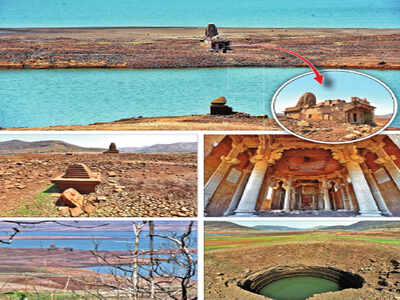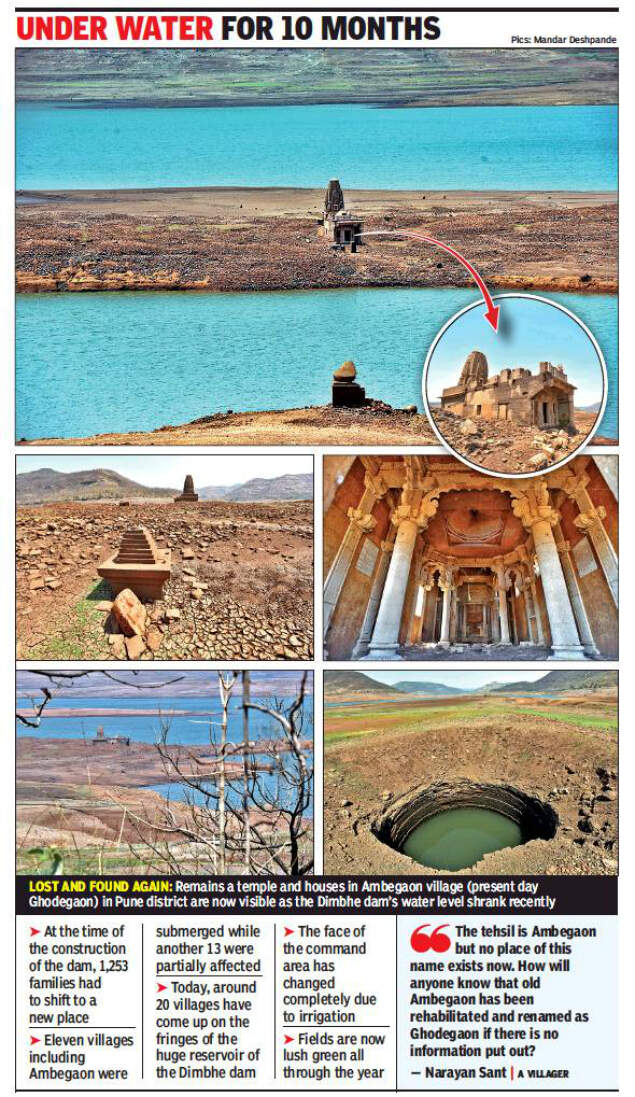
GHODEGAON: For almost two decades, a grocer from the Jain community living in Pune, has been making a trip to the Dimbhe dam every summer. This year, his gaze travelled over the nearly dry reservoir, stopping to take in the rundown, but still standing old temples.
“There is solace in seeing the temples, the houses and the wells. It reminds me of childhood. But every year, something or the other is more damaged than the previous year as all the buildings are under water for ten months,” the man said, not wanting to be named. Like him, many people visit the area in summer to see the dilapidated structures.

The remains of old homes, a well and a Jain temple in the old Ambegaon village, today’s Ghodegaon, are visible now after many years after the water in the reservoir of the Dimbhe dam receded considerably this summer.
During the construction of the dam in the 1990s, the land belonging to at least 25 villages, including Ambegaon, was submerged and the villagers were rehabilitated in different places in Ambegaon tehsil. At present, many villagers are trooping to the site, recalling their memories.
The remains of the houses, temples and other structures are strewn around in the middle of the reservoir. Fishermen have constructed temporary shelters around them. There is no signboard, giving information about the old village on the Malin- Ghodegaon road which goes around the reservoir.
The temple is visible from the road. But no tourists go to the site as it is a few km of trekking. Narayan Sant, a villager from Ghodegaon, said the government reintegrated around 105 families of Ambegaon village in different places, mainly Ghodegaon.
“We still value our old houses and temples that are under water for most of the year. Whenever the water level recedes in summer, we pay a visit to the village and perform the rituals and pooja as a mark of respect to our ancestors’ work,” Khandu Khandagale, another Ghodegaon villager told TOI.
Many are angry that the government did not protect the rich heritage of the village and the neglect has damaged several temples. “After seeing the conditions of the old structures now, we feel bad that such an ancient treasure is lost and we did little to save it. There were only 10 Jain families in the village. But their ancestors had constructed a beautiful temple at the main square of the village which is still in good condition. It is about a 100 years old. The government needs to preserve such structures by relocating it to a new site,” Prakash Gholap, another villager, said.
Vice chancellor Vasant Shinde of Deccan College Postgraduate and Research Institute said several such sites have vanished in Pune and other districts in the last few decades.
“Before construction of dams or airports or any infrastructural project, an agency should carry out a special survey in and around the site to identify historic places,” Shinde told TOI.
“Currently, neither the Centre nor the state government have a specific policy on restoration or relocating of such structures. Many such edifices have disappeared over the decades,” Shinde said.
Historic places can be studied in detail to understand the older civilisations. Such studies provide immense information and references essential to draw parallel with available information and create new theories, he added.
Administrative officials from Ambegaon tehsil said they did not receive any official communication from the villagers about preservation of the old structures.
“There is solace in seeing the temples, the houses and the wells. It reminds me of childhood. But every year, something or the other is more damaged than the previous year as all the buildings are under water for ten months,” the man said, not wanting to be named. Like him, many people visit the area in summer to see the dilapidated structures.

The remains of old homes, a well and a Jain temple in the old Ambegaon village, today’s Ghodegaon, are visible now after many years after the water in the reservoir of the Dimbhe dam receded considerably this summer.
During the construction of the dam in the 1990s, the land belonging to at least 25 villages, including Ambegaon, was submerged and the villagers were rehabilitated in different places in Ambegaon tehsil. At present, many villagers are trooping to the site, recalling their memories.
The remains of the houses, temples and other structures are strewn around in the middle of the reservoir. Fishermen have constructed temporary shelters around them. There is no signboard, giving information about the old village on the Malin- Ghodegaon road which goes around the reservoir.
The temple is visible from the road. But no tourists go to the site as it is a few km of trekking. Narayan Sant, a villager from Ghodegaon, said the government reintegrated around 105 families of Ambegaon village in different places, mainly Ghodegaon.
“We still value our old houses and temples that are under water for most of the year. Whenever the water level recedes in summer, we pay a visit to the village and perform the rituals and pooja as a mark of respect to our ancestors’ work,” Khandu Khandagale, another Ghodegaon villager told TOI.
Many are angry that the government did not protect the rich heritage of the village and the neglect has damaged several temples. “After seeing the conditions of the old structures now, we feel bad that such an ancient treasure is lost and we did little to save it. There were only 10 Jain families in the village. But their ancestors had constructed a beautiful temple at the main square of the village which is still in good condition. It is about a 100 years old. The government needs to preserve such structures by relocating it to a new site,” Prakash Gholap, another villager, said.
Vice chancellor Vasant Shinde of Deccan College Postgraduate and Research Institute said several such sites have vanished in Pune and other districts in the last few decades.
“Before construction of dams or airports or any infrastructural project, an agency should carry out a special survey in and around the site to identify historic places,” Shinde told TOI.
“Currently, neither the Centre nor the state government have a specific policy on restoration or relocating of such structures. Many such edifices have disappeared over the decades,” Shinde said.
Historic places can be studied in detail to understand the older civilisations. Such studies provide immense information and references essential to draw parallel with available information and create new theories, he added.
Administrative officials from Ambegaon tehsil said they did not receive any official communication from the villagers about preservation of the old structures.
#ElectionsWithTimes
more from times of india cities
Quick Links
Lok Sabha Election Schedule 2019Lok Sabha Election NewsDelhi Capitals teamMI team 2019Rajasthan Royals 2019RCB team 2019Maharashtra Lok Sabha ConstituenciesBJP Candidate ListBJP List 2019 TamilnaduShiv Sena List 2019AP BJP List 2019Mamata BanerjeeBJP List 2019 MaharashtraPriyanka GandhiBJP List 2019 KarnatakaAMMK Candidate List 2019BJP List 2019 WBLok Sabha Elections in Tamil NaduBSP List 2019 UPNews in TamilLok Sabha Poll 2019Satta Matka 2018PM ModiMahagathbandhanNagpur BJP Candidate ListChandrababu NaiduTamil Nadu ElectionsUrmila MatondkarNews in TeluguMadras High CourtTejashwi YadavArvind KejriwalTejasvi SuryaPawan KalyanArvind KejriwalYogi AdityanathJaya PradaSatta King 2019Srinagar encounter
Get the app











